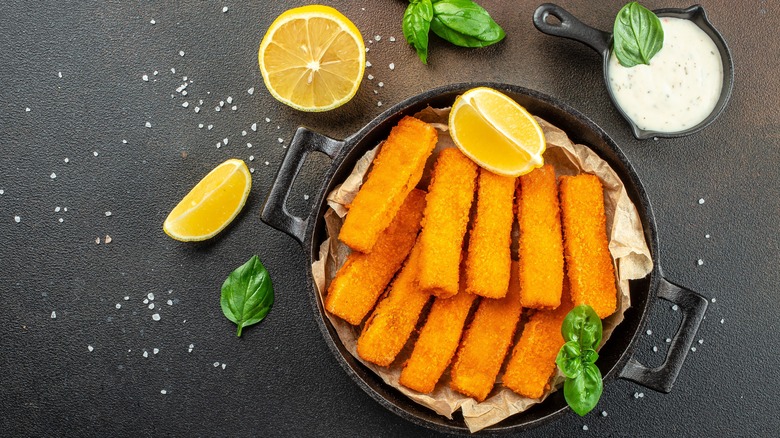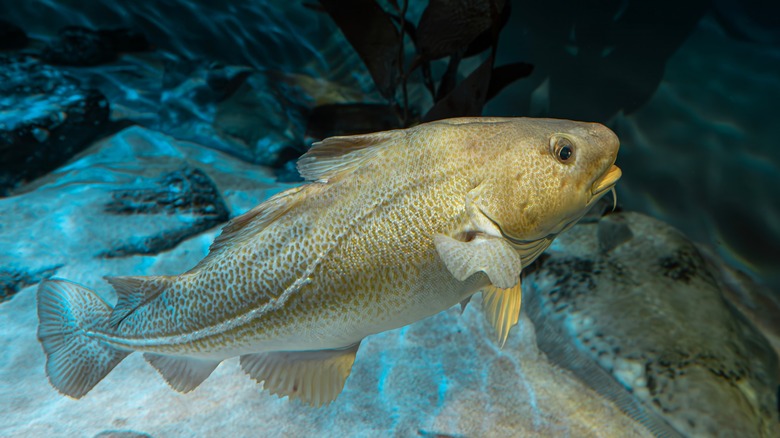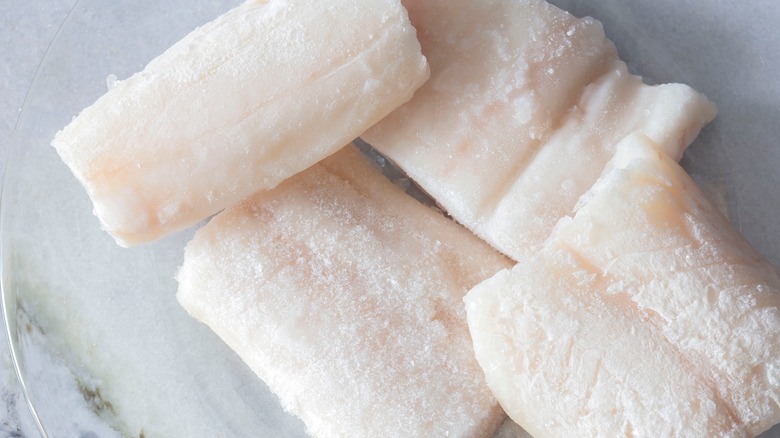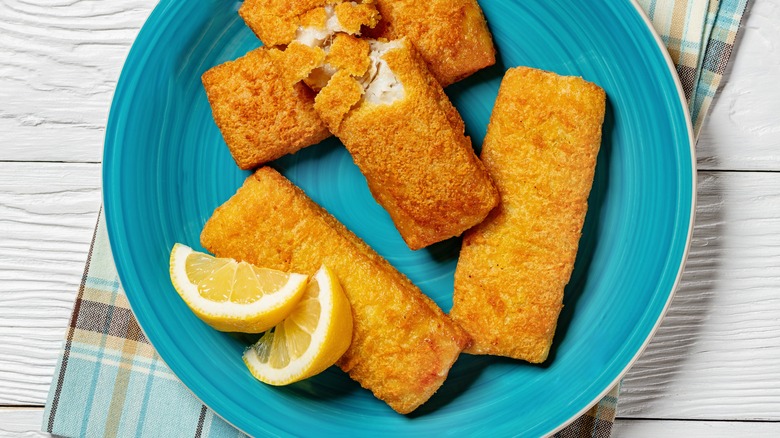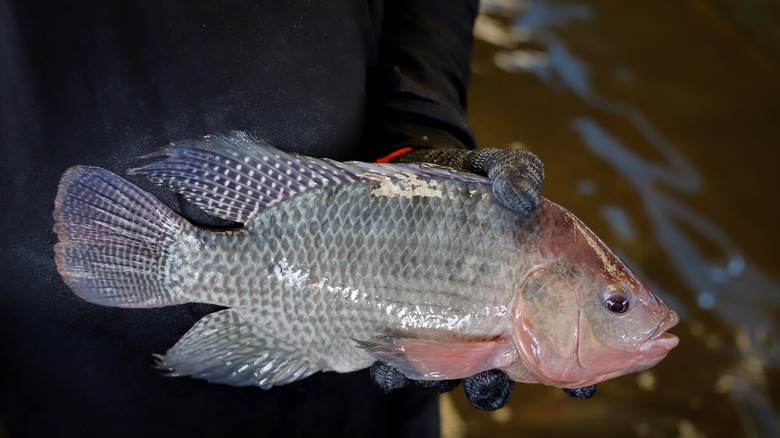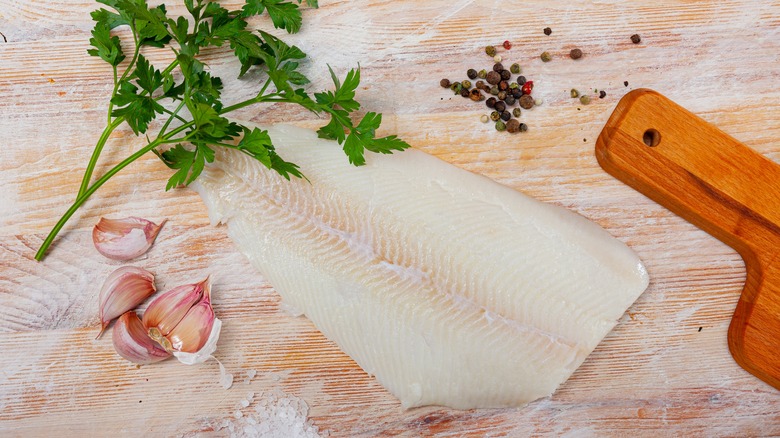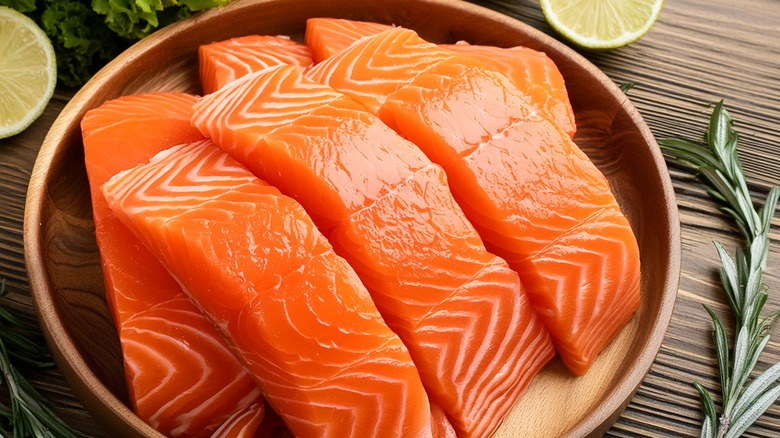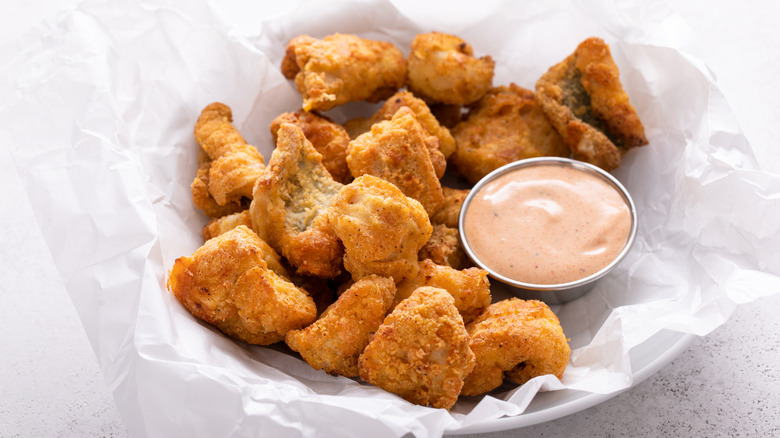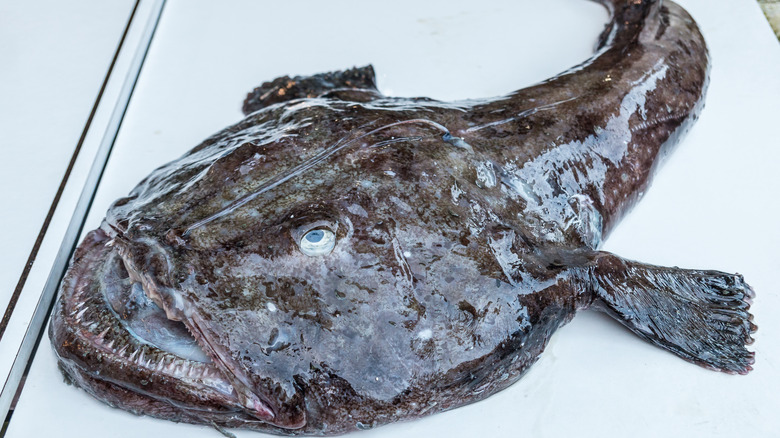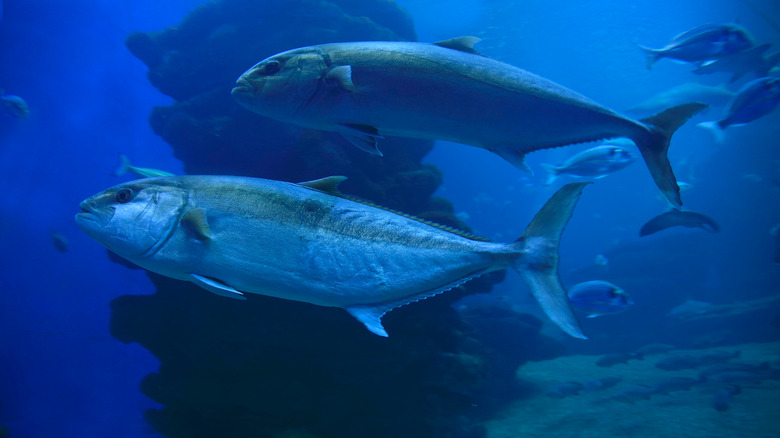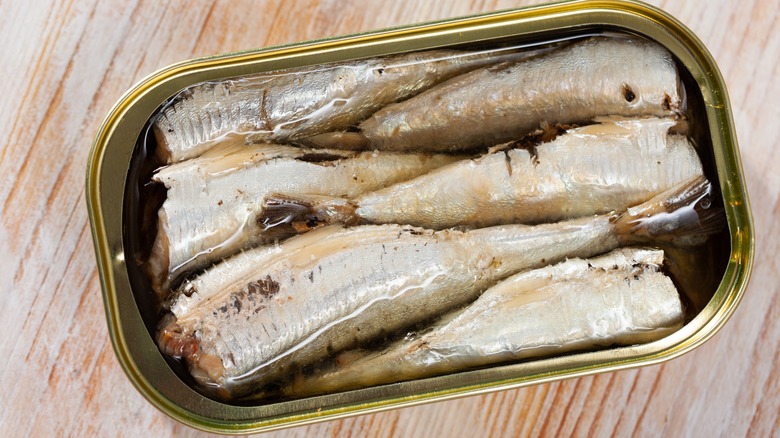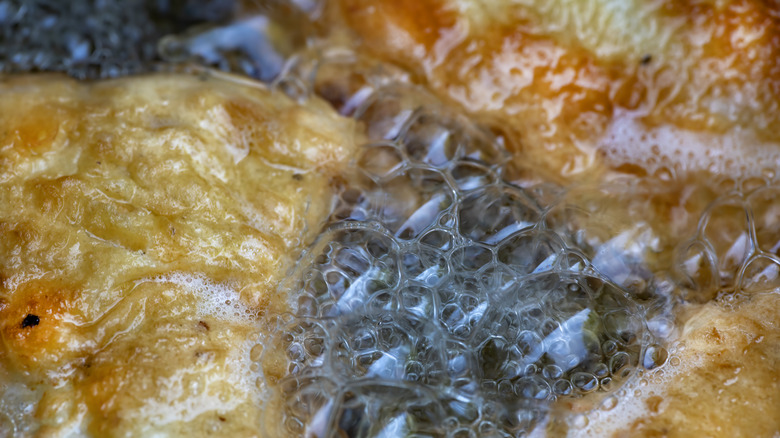The Best Types Of Fish To Use When Making Homemade Fish Sticks, According To Chefs
If you open up the average family's freezer, you will likely find a box of frozen fish sticks. Known as an easy kid-pleaser for a quick weeknight meal, fish sticks can be a versatile protein to use in numerous dishes. Fish sticks can be even fresher and more delicious if you take the extra time to make your own. Not only do you get to customize your sticks to your taste buds, but you also get the opportunity to source your fish. One of the biggest mistakes you can make with homemade fish sticks is picking the wrong fish. "When it comes to making fish sticks, you need to choose fish that are firm with a mild taste. They also need to be able to stay firm during the cooking process," said Joe Bowab, the CEO and founder of Lobster Anywhere. "You also want a fish that can absorb the marinade or seasonings added to the mix to enhance the flavor of the fish stick."
Experts have weighed in on some of the best classic picks, as well as some more non-traditional choices that will have your family ditching the frozen box of fish sticks and raving for your homemade ones instead! Whether you try out making your own for National Seafood Month or National Pescatarian Month, read on to get inspiration and some expert tips.
Cod
If you order fish and chips in a restaurant, chances are it likely would be cod. "Cod is a classic choice because of its mild flavor and firm texture, making it easy to bread and fry," said Allie Hagerty food blogger and recipe creator at Seasoned and Salted. That firm texture also makes cod a reliable choice for fish sticks, as it holds together well when it's sliced or cut, according to Rima Kleiner, a registered and licensed dietician and nutritionist at Dish on Fish.
You can find cod in the Atlantic and Pacific, but you are likely consuming the Atlantic species. If you are looking for an option that is similar to cod, try out hake, which is a sustainable fish option in the cod family. What makes it slightly unique from its cod counterpart is its milder taste, softer texture, and smaller flake.
Hake and cod are also favorite choices for Joe Bowab. "These are the best options because they are able to absorb seasonings nicely, and they can hold firm during the cooking process — the last thing you want is a fish stick that is crumbling apart," he said. The good news is there are other fish species with some of the same benefits as cod that make tasty fish sticks.
Haddock
Experts opted for haddock as one of the top three choices for fish sticks. Another member of the cod family, haddock is used interchangeably with cod due to its moist but firm texture. "Haddock is another great option, slightly sweeter than cod but still light and flaky," said Allie Hagerty.
Haddock, a North Atlantic fish, has some differences from cod. Haddock typically is a smaller fish resulting in a thinner, more fragile fillet than cod, meaning it cooks through quickly when fried. Haddock is also described as being a bit more flavorful than cod. The fish also has a noticeable black spot above its pectoral fin and grows quickly. Due to its differences from cod, you will also want to be sure to use the appropriate breading for your haddock. Lighter, flakier fish options like haddock should use a lighter breading, as it helps maintain the texture, according to Hagerty. To ensure freshness when selecting your haddock, you will want to be sure the white fish's flesh is firm and translucent.
Pollock
Another go-to option for fish sticks that you may not hear about as often is pollock, even though it is one of the most commonly used fish for fish sticks commercially. You may also see it in your market as Alaska pollock or Walleye pollock, as it is typically wild caught in the Bering Sea and Gulf of Alaska. This fish is similar to cod or haddock with its mild taste and fine flaky texture. Pollock is even used for imitation crab and commonly in fish sandwiches thanks to its flavor and texture combination.
"Pollock is often overlooked but is a sustainable choice that works beautifully for fish sticks — it's soft and delicate but holds up to breading and frying just as well as the others," said Allie Hagerty. Pollock can also be considered a budget-friendly option, according to Joe Bowab, as it is typically cheaper than cod in most places. However, you do want to be careful about overcooking pollock, as it can lose its shape quicker than its cod counterpart. If cooked properly, pollock keeps its shape and texture when exposed to high heat.
Tilapia
Tilapia is both a budget-friendly and easy-to-find option for fish sticks, as it is widely farmed across the world. While it may not the first fish you think of to pick for fish sticks, those of us in the United States seem to enjoy it — it is estimated we each eat about a pound of tilapia every year on average. Tilapia is a freshwater fish, although it can be tolerant of saltwater. While tilapia is considered to have a firmer texture sought after in fish stick making, it may not be as firm as other fish options like cod or haddock. "Tilapia is suitable for those who prefer a softer texture to their fish sticks," said Joe Bowab.
There can be some sustainability concerns for tilapia with it being farmed. However, organizations like the Monterey Bay Aquarium Seafood Watch program offer suggestions on how to find sustainable options — but it can be more difficult to source the highest-rated sustainable options.
Halibut
Halibut may be the perfect pick for home chefs looking for a more elevated fish stick than the store-bought boxed variety. In fact, Joe Bowab calls halibut a more gourmet option that he uses for dinner parties. This white fish is firmer and thicker than other options, but still offers a mild flavor, according to Allie Hagerty.
There are both Pacific and Atlantic halibut options, but the more common is the Alaska (Pacific) species. While halibut may be a delicious option, you want to prepare yourself for the price tag, as it is generally a pricier option than other fish. This is because halibut is rarer than fish like haddock, and takes more time and effort to catch or raise.
If you opt for halibut, you can leave it semi-frozen and cut it into sticks to prevent your fish sticks from falling apart as easily. Hagerty said the key for prepping the firmer fish like halibut is to "cut the pieces a little thinner to ensure they cook evenly and don't get too dense."
Salmon
Another more gourmet option for fish sticks is salmon. Founder and chef at Savory Experiments, Jessica Formicola said while fish sticks are traditionally made with milder fish, "more flavorful varieties like salmon or red snapper add a fun element. You can also use larger pieces of king crab legs or even lobster meat!”
There are a lot of options to choose from as far as the type of salmon. Both Pacific and Atlantic varieties are available, as well as wild-caught or farmed salmon. However, the Atlantic salmon species is typically the majority of farmed salmon and has a rich and fatty taste. Chinook is the most expensive salmon variety with its fatty, buttery texture, while Sockeye is an oilier, deeper red version as opposed to Coho's mild taste and light pink color. Keep those flavor profiles in mind when at the fish counter.
Another perk of using salmon for fish sticks is the boost of omega-3 fatty acids. Omega-3s, as well as other nutrients found in fish like salmon, can have a positive impact on your heart health. So not only is salmon delicious, it is healthy, too.
Catfish
For fish sticks with a flavorful Southern flair, try frying up some catfish. "Cod tends to be the fish most people rely on to make fish sticks, but there are several species that will work well," said Rima Kleiner, adding that this is the reason that catfish also works well for fish sticks. "You really just need a firm fish that holds together well when sliced or cut but one that's not too meaty."
Named for their whisker-like barbels, catfish is a white fish with a mild flavor that is typically dredged using buttermilk and fried to golden brown perfection. Catfish can be farm-raised or wild-caught, but in stores, you will likely find farmed channel catfish. Freshwater catfish is also popular to catch and eat in some parts of the country — it's considered a staple in the Southeastern United States. You can find catfish on menus in sandwiches, or po'boys, or even in fish tacos.
Monkfish
If you are looking to go outside of your comfort zone with your fish choice and wow your guests, monkfish could be the ticket. ”While cod, haddock, and pollock are the go-to options, you could try something like monkfish. It has a meaty, firm texture that holds up well to frying,” said Allie Hagerty.
Monkfish, a member of the anglerfish family, is not known for its looks. It boasts a large head with two rows of teeth that look almost prehistoric. But its meat is mild and sweet, which results in its nickname "the poor man's lobster.” Monkfish is even considered a delicacy in other countries.
You can find monkfish tails for sale at your grocer in the United States, or buy the entire fish. The monkfish has no small bones to remove, making it easier to fillet than some other fish varieties. But since it is a denser fish, keep in mind that you may need more cooking time than other delicate fish like tilapia.
Mackerel
For our more adventurous seafood crowd, mackerel may be a good choice. ”For those looking for a more flavorful fish, mackerel could be an interesting twist, offering a richer, bolder taste,” said Allie Hagerty. There are dozens of types of mackerel, but the North Atlantic species has a lower mercury content than others like the large king mackerel and Spanish mackerel. Mercury poisoning can be a concern in higher mercury-content fish and should especially be avoided for children, and pregnant or nursing women.
You will want to modify your coating for cooking mackerel fish sticks, as its oily texture will pair better with a ”lighter, crisp coating to balance out the richness,” according to Hagerty. Jessica Formicola echoed the breading advice, suggesting that if you select an oilier fish you should, "use a drier bread crumb whereas a less oily fish is good with either breadcrumbs or a batter." When selecting your mackerel at the fish counter or market, Hagerty said to be on the lookout for clear eyes and shiny skin if buying the fish whole.
Avoid using these types of fish
While experts say you can generally use any type of fish for homemade fish sticks, there are some types that may not be as palatable. "I'd avoid using overly oily or strong-flavored fish like sardines or bluefish for fish sticks — they can overpower the dish," said Allie Hagerty.
You may also want to avoid the super delicate flaky fish like flounder or sole, as you may experience issues with the fish sticks sticking together during cooking, according to Hagerty. Canned fish fall into that same category of not ideal for fish sticks due to texture concerns. "While canned fish makes a great burger patty or cake, it doesn't make for a great fish stick (just won't hold together well for a stick shape)," said Rima Kleiner.
Kleiner also suggested saving the meaty fish like swordfish or tuna for a fillet or steak preparation, as they may be a bit too firm for fish sticks. However, the choice of fish is ultimately up to your taste buds and preferences. "That's one of the great things about fish ... it's so versatile and there are so many species to choose from for making fish sticks, fish burgers, or fish steaks," she said.
How to select your fish
Deciding which fish type to use for your homemade fish sticks is only half the battle. The next step — sourcing your fish — is crucial, as you want to be sure to get the freshest option for optimal taste. "Always look for firm, fresh-smelling fillets with no fishy odor," said Allie Hagerty, adding that you should also ask about where the fish was caught.
If budget is a concern, frozen fillets are also a viable option. "Just allow enough time for them to thaw properly in the fridge before using," said Rima Kleiner. Jessica Formicola suggested asking the fish department about how long ago the fish was thawed out for freshness reasons.
If all else fails, talk to the fishmongers themselves, as they can guide you in the right direction of what they have in stock that day that would work best for fish sticks. "When choosing fish, I always recommend considering sustainability too, so looking for wild-caught or responsibly farmed options is key," said Hagerty. "Growing up in a family of fishmongers, quality and sourcing have always been top priorities, and I think it's an important piece of the puzzle when making seafood dishes at home."
The easiest tip for sourcing fresh fish is to rely on your nose. "Smell the fish. Some scent is fine, but when it is bad, you know," said Formicola.
Cooking tips
After you make your fish selection, the fun really begins. The cooking technique is another key decision when making your fish sticks. The process of making the fish sticks largely stays the same no matter what fish you select, with the first step being to prepare your fish for cooking. "Blot dry your fish and sprinkle on a little salt and pepper. Then, organize your two shallow bowls — one with your breading (typically panko, cornmeal, almond meal or flour) and dry herbs or Old Bay and a second with your wet ingredients (like whisked egg, sometimes mixed with yogurt or kefir)," said Rima Kleiner, adding that kefir, a tangy fermented drink, is her secret step to add flavor and help the breading stick to the fish through cooking. "Dip each fish stick in the wet ingredients, then dip and cover with the breading."
The big debate is whether to bake or fry your fish sticks. That choice is up to you, as fish sticks can be either fried or baked. If frying, Joe Bowab says to "coat the fish and then fry it in hot oil for about three minutes on each side." If you opt for the oven, bake your sticks at 450 degrees Fahrenheit for about 15 minutes. The air fryer is also an option. Whichever method you choose, be sure to not overcook your fish sticks, aiming for a golden brown, crisp crust that will blow store-bought fish sticks out of the water.
